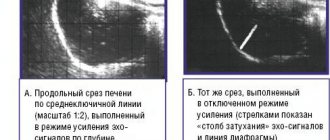Chronic diffuse liver diseases often occur in women of childbearing age. The most common form of liver damage is chronic hepatitis of viral etiology, more rare are autoimmune and drug-induced hepatitis, cholestatic forms of damage (primary biliary cirrhosis, primary sclerosing cholangitis), alcoholic liver damage, non-alcoholic steatohepatitis (due to obesity, diabetes mellitus), Wilson's disease - Konovalova and others.
Recent decades have been marked by an increase in the number of people infected and suffering from viral chronic liver diseases (CLD), especially among young people, as well as the emergence of a number of new drugs that allow successful etiopathogenetic treatment of some forms of liver damage. This leads to an increase in the number of pregnant women and postpartum women suffering from CKD. Features of the course of CKD in pregnant women, management tactics for such patients, in particular, indications for drug treatment and issues of its safety have not been sufficiently studied.
General information
Speaking about diffuse changes in the liver , you should first of all understand what this concept means. This condition is not a disease, but a symptom of diseases that manifest themselves as a result of decreased immunity , poor nutrition, alcohol abuse, taking toxic medications, etc. Due to negative effects, connections between molecules are disrupted.
The functions of hepatocytes also change, as a result of which the fatty and connective layer increases. In fact, this is one of the manifestations of liver pathologies, and the correct diagnosis can only be established after a comprehensive examination and consultation with a hepatologist.
This article will discuss how to diagnose this pathology and what needs to be done to improve the condition of the liver.
What are diffuse changes in the pancreas?
A pathogenic change in tissue can be chronic and not manifest itself for a long time.
In older people, especially with pathologies of the cardiovascular system, blood circulation, and those suffering from diabetes, healthy pancreatic tissues often die under the influence of pathogenic circumstances, and in their place connective or adipose tissue is formed.
This condition is not recognized as a disease and therefore cannot be treated. But ultrasound shows increased echogenicity with normal organ sizes. Such transformations are observed in the following violations:
- blood supply to the enzyme-forming organ
- functioning of the biliary tract
- liver function
- metabolic and endocrine processes.
Similar symptoms are characteristic of pancreatitis and dystrophic metabolic disorders. If the diagnosis of pancreatitis is not confirmed, then DIP is not recognized as a disease and treatment is not prescribed. The object of spreading changes, as a rule, is the pancreatic parenchyma, that is, the glandular tissue that performs the main functions of the organ. A pathogenic change in tissue can be chronic and not manifest itself for a long time.
Pathogenesis
Parenchyma is liver tissue that consists of hepatocytes. This tissue is involved in the process of purifying the blood, which, in turn, supplies all vital organs with necessary substances and ensures the normal process of bile .
If the liver is healthy, then the cell structure is homogeneous. Fats that enter the body with foods are broken down by enzymes , after which they enter the liver. In turn, there they are converted into cholesterol , triglycerides , etc. When the amount of triglycerides in tissues increases, a change in the liver parenchyma occurs.
Diffuse changes in the liver and pancreas are quite often observed. Since the organs of the digestive system are connected by ducts, often when one organ fails, another suffers. hepatomegaly may develop , that is, a significant enlargement of the liver . Such changes in the parenchyma can be observed during primary and secondary metabolic disorders, acute or chronic infectious processes.
Hereditary liver diseases
Hereditary chronic liver diseases are quite rare, therefore, even with repeated examinations, they are not recognized by doctors and patients are treated for a long time for other diseases.
The main hereditary liver diseases include: Gilbert's syndrome, hemochromatosis, Wilson-Konovalov disease, etc.
Hemochromatosis is a disease of autosomal recessive inheritance, characterized by impaired iron metabolism, excessive absorption in the intestine, increased content in the blood and deposition in various tissues with increased structure and dysfunction of the liver, heart, and pituitary gland. Clinical symptoms in the early stages of the disease are nonspecific: weakness, fatigue, weight loss, joint pain. The examination reveals an increase in ALT and AST.
In the terminal stage, the classic triad manifests itself: skin pigmentation, cirrhosis and diabetes mellitus. For diagnosis, the level of iron in the blood, transferrin, ferritin, total iron-binding capacity, as well as ALT and AST are determined. Genetic analysis for hemochromatosis reveals the presence of hereditary factors - mutations of the HFE gene. Genetic testing is also carried out for close relatives of patients with confirmed hemochromatosis.
The goal of treatment is to remove excess iron from the body. Good results are obtained by bloodletting under the control of a clinical blood test and the patient’s well-being. In addition, drugs are used to help remove iron from the body and prevent the formation of cirrhosis. Timely initiation of therapy prolongs the life of patients by several decades.
Konovalov-Wilson disease is a hereditary disease based on increased absorption of copper in the intestine and decreased synthesis of the copper-binding protein ceruloplasmin in the liver. This leads to excessive accumulation of copper in the blood and its deposition in tissues with primary damage to the liver, central nervous system, kidneys, cornea and other organs. The clinical picture consists of symptoms of liver damage, neurological and mental disorders. In the early stages of the disease, symptoms of hepatitis, hepatomegaly, and splenomegaly (enlarged liver and spleen) appear. Later, signs of functional liver failure, portal hypertension, jaundice, and a slowly progressive form of cirrhosis increase.
Damage to the nervous system is manifested by hand tremors, speech impairment, prolonged muscle spasms, decreased intelligence up to dementia. A typical sign of the disease is the deposition of a greenish-brown pigment containing copper in the cornea - Kayser-Fleischer rings. Treatment is aimed at removing excess copper from the body - a special diet with a limited copper content and drugs that bind and remove copper.
Classification
Depending on the severity of the pathological process, the following types of changes are distinguished:
- Pronounced - as a rule, develop as a consequence of oncological processes, viral hepatitis , fatty degeneration , alcoholic illness. In this case, treatment involves surgical intervention.
- Moderate - are the result of nutritional disorders, chemical poisoning, metabolic and endocrine disorders. Moderate diffuse changes in the liver parenchyma are treated by taking medications, following a gentle diet, and blood purification.
- Minor – symptoms may not appear for a long time or may be mild. As a rule, they are observed at the very beginning of the pathological process.
The pathological process can be localized in any part of the liver:
- fabrics;
- parenchyma;
- duct wall.
Taking into account the nature of diffuse changes in the liver, the following are distinguished:
- dystrophic;
- heterogeneous;
- reactive.
The following types of parenchyma structure are also distinguished:
- According to the steatotic type , the formation of fat cells occurs chaotically, in separate areas. If cells accumulate in one place, cysts can form.
- According to the type of hepatosis , fat cells spread throughout the tissue, disrupting the normal functioning of the liver. Diffuse changes in the liver, such as hepatosis, appear both as a result of diseases and due to poor nutrition and alcohol abuse.
Taking into account the reasons for such manifestations, the following types of changes in the liver are distinguished:
- sclerotic;
- swelling;
- dystrophic;
- hypertrophic.
Mechanism of development of fatty liver hepatosis
The pathogenetic mechanisms of fatty hepatosis are based on:
- peripheral insulin resistance - a disorder in the signal transmission system that occurs after activation of the insulin receptor;
- decrease in the level of adipose tissue hormone;
- increased accumulation of fats;
- violation of the oxidation of free fatty acids.
A characteristic feature of the pathological condition is an increase in the amount of triglycerides by more than 10% of the total dry weight of the liver. Because of this, during hepatosis, fat droplets are deposited in hepatocytes, the development of “obesity” of liver cells, their subsequent death and replacement with fibrous connective tissue.
Fat can accumulate in liver cells for several reasons:
- due to excess intake of free fatty acids with food;
- excessive formation and binding of free fatty acids in the small intestine;
- reducing oxidative processes in hepatocytes;
- reducing the synthesis of lipoproteins in the liver;
- the presence of functional failure caused by organ disease.
Today, the prevalence of steatosis in the general population reaches 40%.
Causes
The development of diffuse changes in the liver can develop due to the following diseases and conditions:
- Diabetes mellitus and obesity .
- Chronic hepatitis.
- Cirrhosis of the liver.
- The appearance of various neoplasms.
- Viral infectious diseases. Moreover, after recovery, the normal structure of the organ is restored.
- Parasitic infestation.
- Too much fat in the body.
- Autoimmune processes in the liver.
- Long-term use of certain medications, in particular antibiotics .
- Alcohol abuse.
- Unbalanced diet.
- Hereditary tendency.
- Constant stressful situations.
- Unfavorable environmental conditions.
In addition to diffuse changes, the patient may also develop hepatomegaly - enlargement of the liver.
What is diffusion?
Diffuse changes in the pancreas are detected by ultrasound.
Pathological changes in pancreatic tissue can be local (focal) or diffuse (mixed). The term diffusion is used in physics and chemistry. And considering this term from the point of view of these sciences will allow us to better understand the essence of the processes occurring in our body.
The term diffusion comes from the Latin word, and means interaction, spreading. In other words, this is the penetration of molecules or atoms of one substance between molecules or atoms of another substance.
The phenomenon of diffusion can be observed when ink is poured into water. In anatomy, diffusion means the interpenetration and replacement of some tissue cells by others. This phenomenon is often observed in the pancreas, where pathologically altered cells coexist with healthy ones. Therefore, diffuse transformations of the pancreas are usually detected by ultrasound.
Symptoms
The main signs of diffuse changes in the liver are as follows:
- Excessive sweating and increased fatigue. If sweating is associated specifically with damage to the liver and pancreas, the sweat has an unpleasant, pungent odor. The person complains of drowsiness, weakness, and extreme fatigue even with light exertion.
- Aching pain and discomfort in the right hypochondrium. If the pain is very severe, this may indicate inflammatory processes or malignant formations.
- Disruption of the digestion process. Signs of parenchymal damage are frequent nausea and heartburn , loose and frequent stools, changes in the color of stool and urine.
- Yellow coating and cracks on the tongue.
- Yellowness of the eyes and skin.
- Increased body temperature. As a rule, the temperature rises insignificantly and lasts for several weeks.
- Deterioration of the condition of the skin. A rash, papillomas, itching, and peeling may appear.
- Hematomas, bleeding.
- Headaches, irritability, frequent mood swings.
Symptoms of liver fibrosis in adults
Scarring from liver fibrosis can affect the liver's ability to function effectively.
However, fibrosis itself does not cause any symptoms. You may have it and not know it. If fibrosis progresses to cirrhosis, the main symptoms may include:
- constant bruises on the body and bleeding;
- fatigue, confusion and weakness;
- itching;
- poor appetite, nausea and weight loss;
- swelling of the abdomen (ascites) and legs (pasty);
- yellowing of the skin and eyes (jaundice).
Liver cirrhosis is a serious disease that can lead to life-threatening complications. Seek medical help immediately if you experience the above symptoms.
Tests and diagnostics
In order for the course of treatment to be as effective as possible, it is necessary to carry out all the prescribed studies that will help confirm the diagnosis and determine the characteristics of the course of the pathological process.
First of all, patients undergo an ultrasound of the liver. It is advisable to conduct such a study periodically and as a preventive measure for healthy people. Echography allows you to determine liver pathologies and their features.
Also during the diagnostic process the following studies can be carried out:
- Radionuclide scanning - carried out if liver damage is suspected after injury, to determine metastases .
- Computed tomography - allows you to determine the presence of tumors, foci of parenchymal bleeding, etc.
- biopsy - using this procedure, tissue is taken for histological examination.
- Biochemical blood test with liver tests.
- Test for antibodies to the hepatitis virus.
Treatment with folk remedies
For diffuse changes in the liver parenchyma in mild to moderate form, some traditional methods that help improve the condition may be an additional treatment method. But before using any of these remedies, you should consult your doctor and get his approval.
- Herbal decoction . To prepare it, you need to take milk thistle and strawberry leaves, dandelion roots, rose hips and corn silk in equal proportions, grind everything in a blender. 2 tbsp. l. Pour 500 ml of boiling water over the mixture and leave for several hours. Strain and add boiled water so that you end up with 500 ml of decoction. Take 100 ml before meals three times a day.
- Oat jelly . Pour crushed oat grains into a three-liter jar so that the grain occupies a third of the jar, and completely fill it with water. For sourdough, you can use a crust of rye bread or half a glass of kefir. The starter must ferment for 4 days. Next, it is filtered and infused for another 12 hours. After this, the liquid is drained and the grounds are kept in the refrigerator. To prepare jelly you need to take 8 tbsp. l. grounds, pour 2 glasses of water over them and cook over low heat for 5 minutes. Use in the morning on an empty stomach.
- Infusion of sage and calendula . Mix 3 tsp. calendula and 2 tsp. sage, pour 250 ml of boiling water. After 30 minutes, strain and drink in two doses a day.
- Herbal infusions . They can be prepared from rose hips, milk thistle, string, chamomile, and lemon balm. To prepare the infusion, 2 tsp. of the selected product or mixture thereof, add 250 ml of water.
- Pumpkin , flaxseed , olive oil . The selected oil should be drunk on an empty stomach, 1 tbsp. l. for 1-2 months.
Diet
Diet 5th table
- Efficacy: therapeutic effect after 14 days
- Duration: from 3 months or more
- Cost of products: 1200 - 1350 rubles per week
During the treatment and rehabilitation process, it is extremely important to adhere to the principles of dietary nutrition. After all, a proper diet helps restore the normal state of liver tissue and improve well-being. If the pathological changes are weakly degenerated, then dietary nutrition will help eliminate the problem without additional medication.
If the patient is undergoing treatment for such a pathology, the doctor recommends following the diet Table No. 5 .
It is recommended to include the following products and dishes in the menu:
- Day-old bread, crackers.
- Lean meat.
- Lenten soups, borscht.
- Puree of fruits and vegetables, boiled vegetables.
- Low-fat fermented baked milk, kefir, cottage cheese.
- Fresh fruit and vegetable juices.
- One boiled egg a day.
- Weak tea, rosehip decoction, dried fruit compote.
You should eat in small portions, 5-6 times a day. All dishes need to be steamed, boiled, stewed, baked.
The following should be completely excluded from the diet:
- Lard, fatty meat, fatty broths.
- Fatty fish.
- Legumes.
- Smoked meats.
- Mushrooms.
- Canned food.
- Coffee.
- Soda, alcohol.
- Sour berries and fruits.
- Confectionery.
List of sources
- Diseases of the liver and biliary tract: A guide for doctors / Ed. V.T. Ivashkina. M.: M-Vesti, 2002. 416 p.
- Ivashkin V.T., Yushchuk N.D. Diagnosis and treatment of diffuse liver diseases. Method, manual for doctors. M.: 2003. - 49 p.
- Mizandari M., Mtvardze A., Urushadze O. et al. Complex radiodiagnosis of diffuse liver pathology // Med. visualization. - 2002. - No. 1. - P. 60-68.
- Panfilov S.A., Panfilova E.V. Diagnosis of liver and biliary tract diseases with a course of pathological anatomy. - M.: Binom. Knowledge Laboratory, 2003. 211 p.
- Stepanyan I.A., Kobinets Yu.V., Izranov V.A., Ovchinnikov O.I. Diffuse liver changes: assessment of diagnostic efficiency using standardized arfi-elastometry. Radiation diagnostics and therapy. 2018;(1):30-35.








